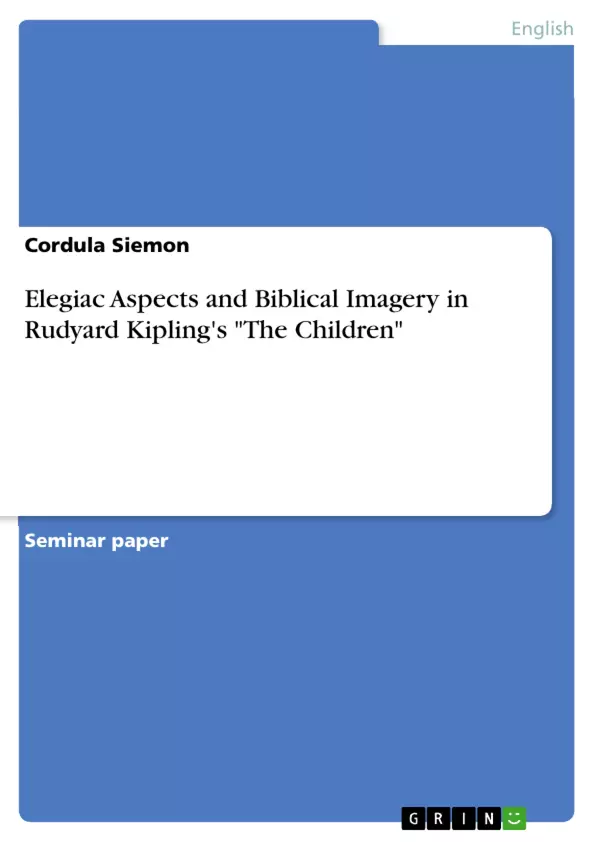After Rudyard Kipling came to fame in the 1890s with poems such as "Mandalay", "Tommy" and "The White Man's Burden", he was increasingly associated with jingoism and imperialism. Indeed, his most popular poems reflect a sense of glamour and excitement about war and Kipling himself was rather open about his anti-liberalism. When the outbreak of the First World War was imminent, Kipling manifested his militarist inclination in his poem "For All We Have and Are", which can essentially be summed up as a public call to arms.
The tone in Kipling's poetry changed towards "a new air of
sadness and loss" (Keating 199) when his 18 year-old only son John was reported wounded and missing at the Battle of Loos in 1915 and his body was never recovered. While Kipling shared this fate with many other parents at the time, the irony - and tragedy - lies in the fact that Kipling himself had pulled strings to get his son a commission in the Irish Guards after the boy's extremely poor eyesight had prevented his initial attempts at enlisting.
Sadly, the poems that dealt with this bereavement never received as
much attention as his early verse and were considered "synthetic", having a "dulling effect" (Wilson 63). One of these poems is "The Children", published in 1918 in his last collection of verse "A Diversity of Creatures".
Taking "The Children" as an example, the aim of this research paper here is to demonstrate a different, non-imperialist and elegiac side of Kipling. Furthermore, it will be examined in how far the accusations of low quality are justified and whether this automatically results in a dull poem.
Inhaltsverzeichnis (Table of Contents)
- Introduction
- Formal Analysis
- Rhetoric and Stylistic Devices
- Imagery
- Biblical Allusions
- Trade Imagery
- War Imagery
- Imagery
- Elegiac Aspects
Zielsetzung und Themenschwerpunkte (Objectives and Key Themes)
This research paper aims to demonstrate a different, non-imperialist and elegiac side of Rudyard Kipling's work, focusing on the poem "The Children." The paper examines the poem's formal elements, stylistic devices, and its elegiac aspects, challenging the common criticism of its supposed low quality and dullness.
- Exploring the elegiac aspects of Kipling's work beyond his imperialist themes
- Analyzing the poem's formal elements and stylistic devices
- Challenging the criticism of "The Children" as a low-quality and dull poem
- Examining the poem's portrayal of loss and bereavement during the First World War
- Considering the poem's use of imagery, particularly biblical and war-related imagery
Zusammenfassung der Kapitel (Chapter Summaries)
- Introduction: This chapter introduces the context of Kipling's work and its association with imperialism. It highlights the shift in tone in his poetry after the loss of his son in the First World War and introduces the poem "The Children" as an example of Kipling's elegiac side.
- Formal Analysis: This chapter examines the formal elements of "The Children," comparing it to other poems of the period and focusing on the poem's rhythm, vocabulary, and use of internal rhyme. It explores the potential connection between the poem's formal structure and its themes of loss and confusion.
- Rhetoric and Stylistic Devices: This chapter analyzes the poem's use of imagery, focusing on biblical allusions, trade imagery, and war imagery. It explores how these devices contribute to the poem's overall meaning and impact.
Schlüsselwörter (Keywords)
The main keywords of this work include: Rudyard Kipling, "The Children," elegy, First World War, formal analysis, stylistic devices, imagery, biblical allusions, trade imagery, war imagery, loss, bereavement, criticism, quality, dullness.
- Citar trabajo
- Cordula Siemon (Autor), 2006, Elegiac Aspects and Biblical Imagery in Rudyard Kipling's "The Children", Múnich, GRIN Verlag, https://www.grin.com/document/157028



